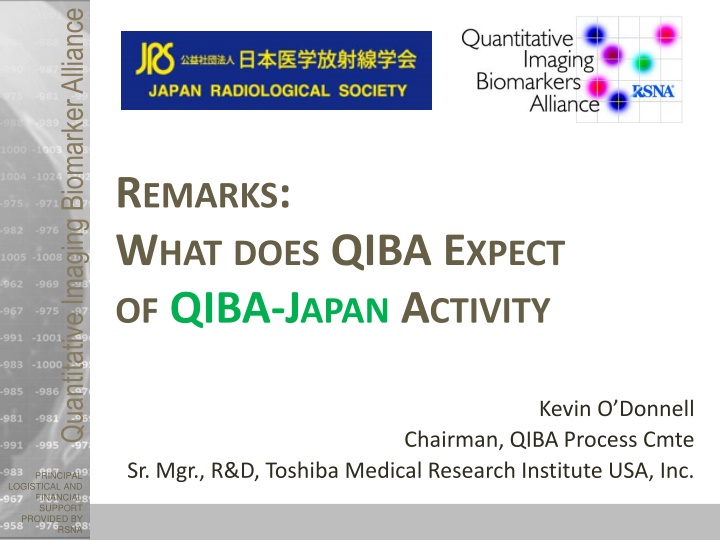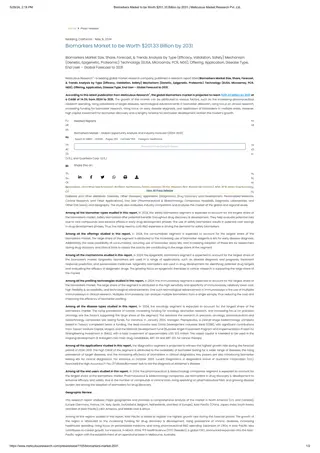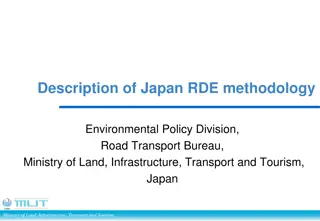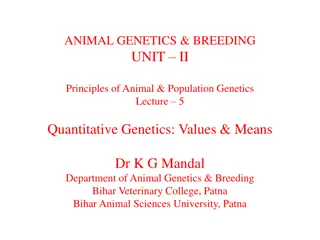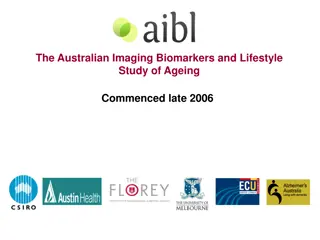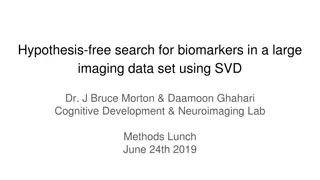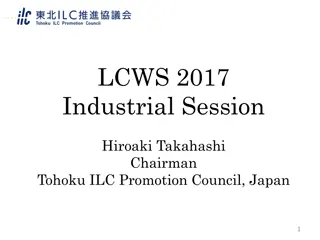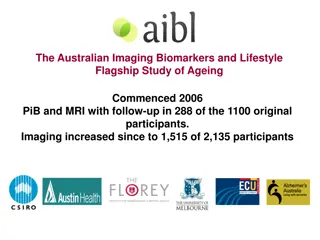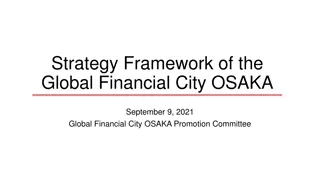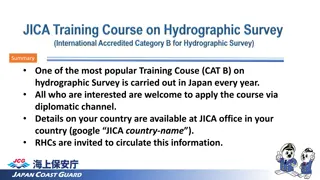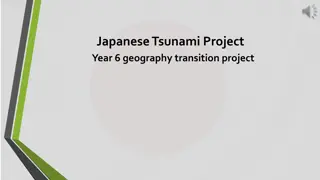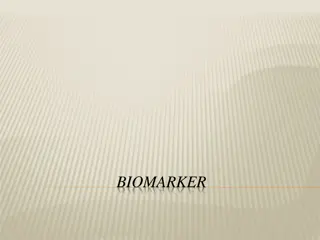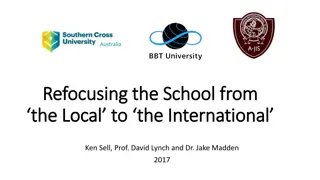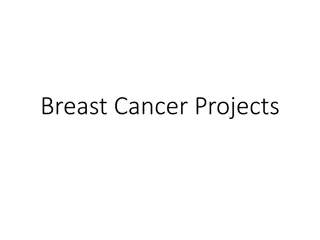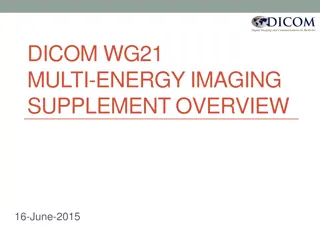Revolutionizing Quantitative Imaging Biomarkers with QIBA-Japan Collaboration
Explore the expectations and initiatives of QIBA in Japan, focusing on improving biomarkers, enhancing clinical decisions, and setting standards for performance metrics. Learn how QIBA aims to address sources of variance, optimize procedures, and ensure quality in radiological imaging practices.
Download Presentation

Please find below an Image/Link to download the presentation.
The content on the website is provided AS IS for your information and personal use only. It may not be sold, licensed, or shared on other websites without obtaining consent from the author.If you encounter any issues during the download, it is possible that the publisher has removed the file from their server.
You are allowed to download the files provided on this website for personal or commercial use, subject to the condition that they are used lawfully. All files are the property of their respective owners.
The content on the website is provided AS IS for your information and personal use only. It may not be sold, licensed, or shared on other websites without obtaining consent from the author.
E N D
Presentation Transcript
Quantitative Imaging Biomarker Alliance REMARKS: WHAT DOES QIBA EXPECT OF QIBA-JAPAN ACTIVITY Kevin O Donnell Chairman, QIBA Process Cmte Sr. Mgr., R&D, Toshiba Medical Research Institute USA, Inc. PRINCIPAL LOGISTICAL AND FINANCIAL SUPPORT PROVIDED BY RSNA
The author has conflict of interest to disclose with respect to this presentation Company / Organization Employee, Toshiba Medical Research Institute USA, Inc.
Clinical Decisions from Quantitative Imaging Problem Analysis Solution Protocol Reqs Recon Reqs Resolution Reqs Noise Reqs Treat ? 6 Sources of Variance Differences in: - Patient Handling - Acq. Protocols - Reconstruction - Segmentation . . . Segment. Reqs Wait Patient Prep & Operation Reqs Measure = 7 6 Segment. Reqs Goal Calibration Reqs Treat ! When all participating actors conform Wait 2 Measure = 7
Improving Biomarkers in QIBA Document Biomarker Procedure Define a Performance Metric Measure Current Performance Publish & Implement Profile Analyze Sources of Error Revise Procedure to Compensate Japan Radiological Society JRS 2016 4
QIBA Profile Structure Claims: User Perspective Vendor View 95% probability that measured change -25% to +30%encompasses the true tumor volume change Requirements: Actor Table Scanner Measurement Software Radiologist Activity Definitions Calibration / QA Patient Preparation Image Acquisition Reconstruction Post-Processing Analysis / Measurement Reading / Interpretation Assessment Procedures: Image Noise and Resolution Tumor Volume Change Variability Site Performance Will it do what I need? Why do you want me to do this? What/who do I need involved? Which of my products are affected? What do I have to do (requirement checklists: procedures, training, performance targets) to achieve the Claims? What do I have to implement; (requirement checklists: features, capabilities, performance targets) How will I be tested? Japan Radiological Society JRS 2016 5
QIBA Profile Stages Progressive levels of stability and confidence Stage Name Stage Meaning Stage Criteria Open issues clearly listed Some groundwork may be ongoing Actor requirements clear & justified Draft for Public Comment Key factors affecting claim are described and procedures address each/most of the factors. Publically Reviewed Consensus reached and ready for trial implementation. Text reasonably stable Public Comments addressed Open issues mostly resolved Technically Confirmed Profile is practical to understand and implement. Text stable Open issues resolved Procedures implemented at test site Claim Confirmed Claimed performance can be achieved. Performance measured at test site Profile Claims achieved Clinically Confirmed Claimed performance will typically be achieved. Profile Claims achieved in clinical use at multiple sites Japan Radiological Society JRS 2016 6
Goal Stage 1: Draft for Public Comment Performing groundwork, drafting Profile: CT Lung Density US Shearwave Speed for Liver Fibrosis fMRI BOLD Brain Mapping for Surgery MR DWI-ADC MR Elastography PET Amyloid QIBA Japan already has Mirror Committees MR, CT, NM, US Give your advice, experience & feedback About physics / engineering / medical / workflow About the templates and process Balancing perfection vs practical progress Japan Radiological Society JRS 2016 7
Goal Stage 1: Draft for Public Comment Performing early groundwork: CT Tumor Volume Change (liver) US Volume Blood Flow in Renal Transplants MR DCE-MRI with 3T and parallel imaging MR Dynamic Susceptibility Contrast (DSC-MRI) MR Diffusion Tensor Imaging (DTI-DWI) MR Proton Density Fat Fraction (PDFF) SPECT for Dopaminergic Degeneration in Basal Ganglia Join or lead groundwork project E.g. Test-Retest, Phantom, DRO, Meta-analysis) Consider NIH-NIBIB funding pattern/process Some projects may also be worth repeating Japan Radiological Society JRS 2016 8
QIBA Profile Stages Progressive levels of stability and confidence Stage Name Stage Meaning Stage Criteria Open issues clearly listed Some groundwork may be ongoing Actor requirements clear & justified Draft for Public Comment Key factors affecting claim are described and procedures address each/most of the factors. Publically Reviewed Consensus reached and ready for trial implementation. Text reasonably stable Public Comments addressed Open issues mostly resolved Technically Confirmed Profile is practical to understand and implement. Text stable Open issues resolved Procedures implemented at test site Claim Confirmed Claimed performance can be achieved. Performance measured at test site Profile Claims achieved Clinically Confirmed Claimed performance will typically be achieved. Profile Claims achieved in clinical use at multiple sites Japan Radiological Society JRS 2016 9
Goal Stage 2: Publicly Reviewed (Consensus) Collecting/resolving comments to reach Stage 2: CT Small Nodule Volumetry Give your advice, experience & feedback About physics / engineering / medical / workflow Propose ideas for unresolved issues Japan Radiological Society JRS 2016 10
QIBA Profile Stages Progressive levels of stability and confidence Stage Name Stage Meaning Stage Criteria Open issues clearly listed Some groundwork may be ongoing Actor requirements clear & justified Draft for Public Comment Key factors affecting claim are described and procedures address each/most of the factors. Publically Reviewed Consensus reached and ready for trial implementation. Text reasonably stable Public Comments addressed Open issues mostly resolved Technically Confirmed Profile is practical to understand and implement. Text stable Open issues resolved Procedures implemented at test site Claim Confirmed Claimed performance can be achieved. Performance measured at test site Profile Claims achieved Clinically Confirmed Claimed performance will typically be achieved. Profile Claims achieved in clinical use at multiple sites Japan Radiological Society JRS 2016 11
Goal Stage 3: Technically Confirmed Planning/performing feasibility tests: CT Tumor Volume Change Advanced Disease DCE-MRI for 1.5T Identify potential Japanese test sites Advise about Japanese variation & commonality Evaluate profile requirements and assessment procedures Japan Radiological Society JRS 2016 12
QIBA Profile Stages Progressive levels of stability and confidence Stage Name Stage Meaning Stage Criteria Open issues clearly listed Some groundwork may be ongoing Actor requirements clear & justified Draft for Public Comment Key factors affecting claim are described and procedures address each/most of the factors. Publically Reviewed Consensus reached and ready for trial implementation. Text reasonably stable Public Comments addressed Open issues mostly resolved Technically Confirmed Profile is practical to understand and implement. Text stable Open issues resolved Procedures implemented at test site Claim Confirmed Claimed performance can be achieved. Performance measured at test site Profile Claims achieved Clinically Confirmed Claimed performance will typically be achieved. Profile Claims achieved in clinical use at multiple sites Japan Radiological Society JRS 2016 13
Goal Stage 4: Claim Confirmed Planning/performing field trials: FDG-PET/CT Cancer Therapy Response Identify potential Japanese test sites Lead field trials Identify relevant Pharmaceutical Clinical Trials that need a biomarker procedure Japan Radiological Society JRS 2016 14
QIBA Profile Stages Progressive levels of stability and confidence Stage Name Stage Meaning Stage Criteria Open issues clearly listed Some groundwork may be ongoing Actor requirements clear & justified Draft for Public Comment Key factors affecting claim are described and procedures address each/most of the factors. Publically Reviewed Consensus reached and ready for trial implementation. Text reasonably stable Public Comments addressed Open issues mostly resolved Technically Confirmed Profile is practical to understand and implement. Text stable Open issues resolved Procedures implemented at test site Claim Confirmed Claimed performance can be achieved. Performance measured at test site Profile Claims achieved Clinically Confirmed Claimed performance will typically be achieved. Profile Claims achieved in clinical use at multiple sites Japan Radiological Society JRS 2016 15
Stage 0: Survey & Selection Our biggest challenge has been controlling our enthusiasm The Profile pipeline has limits: QIBA has limited resources to analyze, do groundwork, write, review Radiologists and clinicians cannot assess many new biomarkers every year and integrate them into clinical decision making Regulators and payers want biomarkers proven safe and effective QIBAs job is not exploration; QIBAs job is industrialization Make a biomarker robust, reliable and available Bring it the last mile into clinicians hands where it can help patients Too few biomarkers reach that point Japan Radiological Society JRS 2016 16
Stage 0: Survey & Selection We expect Japan to choose biomarkers based on your expertise, technology, experience and demographics Finding candidates will be easy; choosing will be hard. Dr. Dan Sullivan, founding chairman of QIBA, proposed 5 characteristics: Translational ready to move from research into clinical care Transformational considerable impact on public health Feasible good chance of success in a reasonable time frame Practical cost-effectively use existing resources where possible Collaborative existing interest across stakeholders Japan Radiological Society JRS 2016 17
QIBA Japan Resources Engage radiology research experts Engage clinicians How can biomarkers have greatest clinical impact Engage vendors Help design for a broad range of equipment Engage biostatisticians Many biomarker efforts fail without them Engage policy makers Collaborate on strategic goals, funding, promotion Japan Radiological Society JRS 2016 18
Looking forward to productive collaboration between QIBA & QIBA Japan Japan Radiological Society JRS 2016 19
